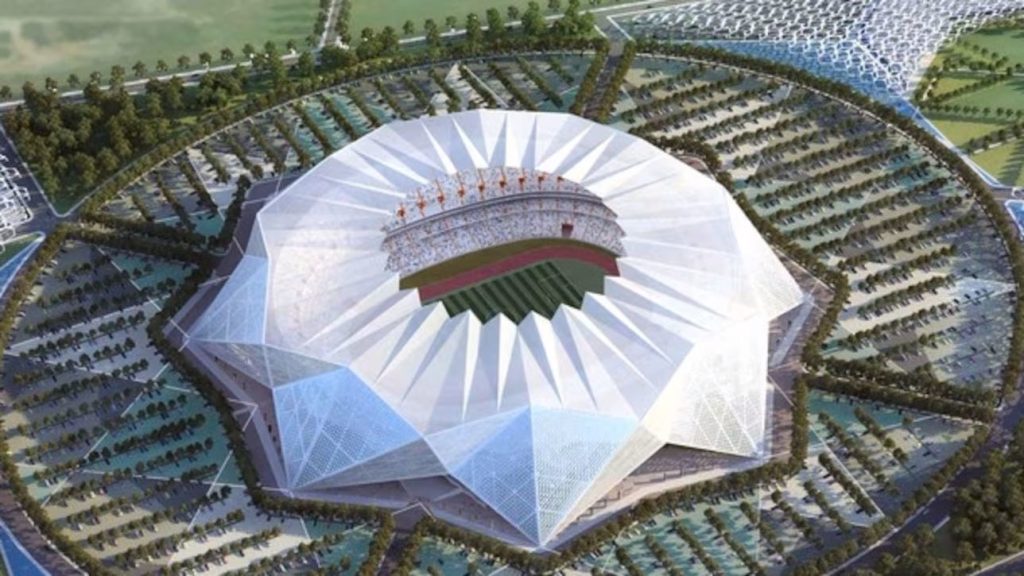Morocco is set to make history by constructing the world’s largest soccer stadium ahead of the 2030 FIFA World Cup, which the country will co-host with Portugal and Spain. The new stadium, named the Grand Stade Hassan II, will be located near Casablanca, Morocco, and will boast an astonishing capacity of 115,000 seats, making it the largest soccer stadium on the planet.

Design and Architecture of the Grand Stade Hassan II
The Grand Stade Hassan II is being designed by renowned architects Oualalou + Choi, in collaboration with stadium experts Populous. The design of the stadium takes inspiration from traditional Moroccan culture, specifically the Moussem, a cultural gathering rooted in Moroccan heritage. The stadium’s architectural design will feature a tent-like form, symbolizing the traditional tents used in Moussem gatherings.
One of the standout features of the stadium will be its aluminum lattice exterior, which not only enhances the aesthetic appeal but also provides essential shade and ventilation for the massive crowds it will host. This design element ensures the comfort of visitors while paying homage to Morocco’s unique architectural styles.
Botanical Gardens and Green Spaces
In addition to the stadium itself, the surrounding landscape will be meticulously designed to complement the structure. A key element of the landscape design is the inclusion of botanical gardens and green spaces, creating a harmonious blend of nature and architecture. The 32 stairways leading to the stadium will be adorned with greenery, turning them into scenic pathways for visitors.
Largest Soccer Stadium in the World

With a seating capacity of 115,000, the Grand Stade Hassan II will surpass the current largest soccer stadiums, including those in the U.S. and elsewhere. For comparison, the largest stadium in the U.S., Michigan Stadium, holds 107,601 sports fans, while the Grand Stade Hassan II will comfortably accommodate even larger crowds.
The stadium is set to be a new home for two local Moroccan soccer clubs and will be the epicenter of soccer in Morocco for years to come. Its construction marks a monumental achievement for the country, firmly positioning Morocco as a central figure in global sports events.
Cultural and Environmental Significance
Lead architect Tarik Oualalou, a founding partner at Oualalou + Choi, emphasized the importance of the stadium’s deep connection to Moroccan culture. He described the Grand Stade Hassan II as a reflection of Morocco’s rich traditions and natural landscapes, stating:
“The Grand Stade Hassan II is deeply rooted in Moroccan culture, with its traditions and contemporary expressions. It’s a generous space, open to the world and respectful to the nature it protects.”
The stadium is not just about scale; it’s also about Moroccan hospitality. The expansive design of the venue will create a welcoming atmosphere for international visitors while staying true to the country’s cultural roots. The tent and garden motifs, combined with the topography of Morocco, symbolize the Moroccan tradition of hospitality, which the stadium aims to showcase to the world.
Location and Construction Timeline
The Grand Stade Hassan II will be built on a 100-hectare site in El Mansouria, a location near Casablanca, Morocco. Construction preparations have already begun, and while the exact completion date has not been announced, the stadium is expected to be finished by 2030, in time for the 2030 FIFA World Cup.
This stadium will undoubtedly become a global landmark, representing Morocco’s commitment to the future of sports and its cultural heritage.
Conclusion
The Grand Stade Hassan II will be a monumental achievement, blending innovative design, cultural symbolism, and sustainability. As the world’s largest soccer stadium, it will not only host matches for the 2030 FIFA World Cup but also stand as a testament to Morocco’s architectural prowess and its commitment to global sports. Whether you’re a soccer fan or a lover of architecture, this stadium is set to be one of the most exciting new landmarks in the world by 2030.
Source : 1 ,

